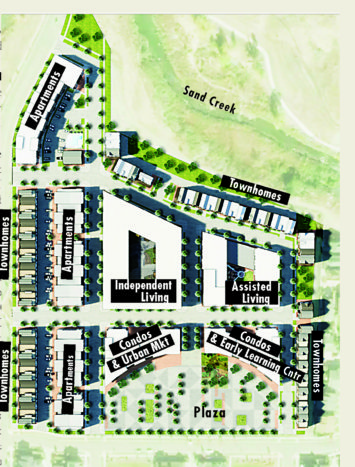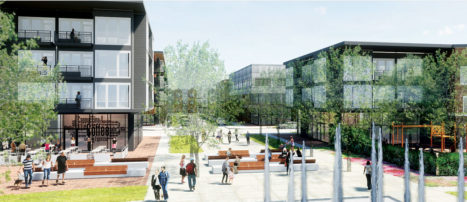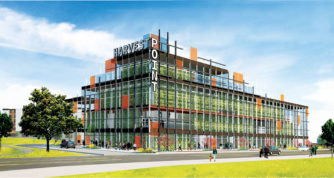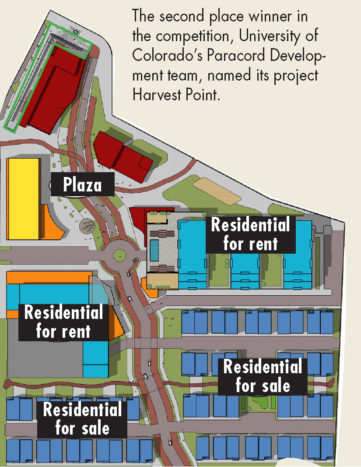
The winner of the annual Rocky Mountain Real Estate Challenge was Denver University’s Odyssey Development Group, which named their project Strommen, a Swedish word that loosely translates to “by the stream.” The focus of the project was to create a diverse residential community with a variety of housing options including townhomes, condos, market-rate apartments and a senior living campus where residents can age in place.
The DU Team’s winning site plan shows their use of the land for 558 residential units spread between the different types of housing. It went lightly on commercial space, with just 4,000 square feet for an urban market and a similar sized early childhood learning center. A consideration in the team’s design was to have a 1:1 ratio of floor area to land.
Business students from the University of Colorado and the University of Denver recently competed in the 16th Annual Rocky Mountain Real Estate Challenge to create the best development plan for 15 acres in Stapleton owned by RK Mechanical, Inc.

The rendering shows the plaza and condo buildings in the Strommen project.
RK purchased the land in 1999, before Stapleton development began—land that is now conveniently located just east of the Central Park Train Station. The growing company, which provides mechanical, electrical and plumbing contracting; steel fabrication and erection; and water treatment solutions, among other services, now has 2,000 employees. With a need for more space than their current 90,000-square-foot building offers, they leased a 280,000-square-foot facility in Aurora. RK COO Jon Kinning says the company is moving gradually and has no specific timeline for when they will sell their Stapleton property or partner with a developer for its future use.

Harvest Point’s central feature is described as, “Colorado’s first vertical hydroponic greenhouse. This four-story urban farm, encased in glass and illuminated with its agricultural LED lighting, will be visible from I-70 and the A-Line, both day and night, drawing visitors from across the Front Range.”
An architect RK has been working with to discuss future use of the Stapleton land—who is on the board of the Rocky Mountain Real Estate Challenge—suggested the future development of RK land would be a good subject for that annual student competition. RK agreed.
The students’ ideas for the highest and best use of their land were exciting, says Kinning, but he emphasizes that this was a student project—not an actual plan for development. At this time RK has not made a decision exactly when the land will be sold or how it will be developed.

The second place winner in the competition, University of Colorado’s Paracord Development team, named its project Harvest Point. The for-sale residential shown in the site plan is described as “stacked flats…a unique housing product that young families, young professionals, and empty-nesters can afford.” The rental includes studio, one-, two-, and three-bedroom high-end units with amenities for an urban lifestyle. The plan includes a total of 434 living units and 112,000 square feet for restaurant, retail and small office in the area around the plaza. The 16,000-square-foot vertical growing space would be operated by an experienced hydroponic food producer.
In this year’s competition, the students’ development projects were judged based on how well they addressed the following objectives set out by RK for their 15 acres in Stapleton, after the business moves to another site:
- Maximize value for RK which may include selling the land or using the land as equity in the development
- Maximize profit for the developer
- Integrate into the surrounding neighborhood of predominately single
family homes - Have a sustainability component
- The primary sponsors of the competition were NAIOP, a commercial real estate development association for developers, owners and investors and Land Title. Judging of the student projects by development professionals was based on:
- The financing and ownership strategy that generates the best risk-adjusted return
- The creation of a vibrant, inclusive and environmentally sustainable development
- Consideration of market conditions, pricing, and returns to an investor.
The final competition came down to the two plans shown here, with an all-day judging session on May 3—and a presentation of the students’ plans at an event attended by hundreds of real estate development professionals, where the winner was announced.




Thank you for the info–I totally missed this article. Someone said she had talked to some employees and they thought the business would be out of here by mid November and they thought that a college was BUYING it. I have observed that the regular guys no long smoke in front of our house and the traffic is diminished. I wish we knew for sure.
Thanks for sharing – very interesting!